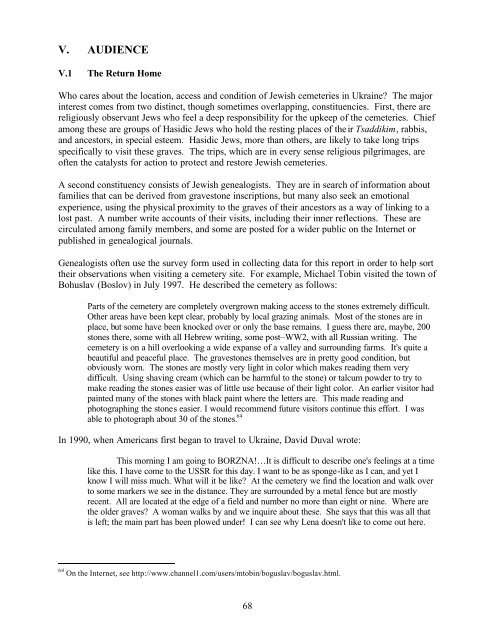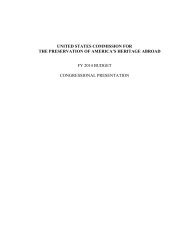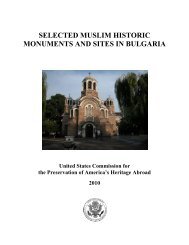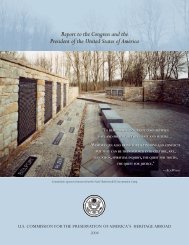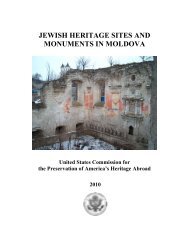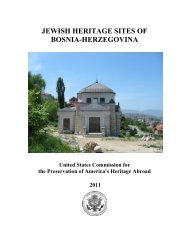jewish cemeteries, synagogues, and mass grave sites in ukraine
jewish cemeteries, synagogues, and mass grave sites in ukraine
jewish cemeteries, synagogues, and mass grave sites in ukraine
You also want an ePaper? Increase the reach of your titles
YUMPU automatically turns print PDFs into web optimized ePapers that Google loves.
V. AUDIENCE<br />
V.1 The Return Home<br />
Who cares about the location, access <strong>and</strong> condition of Jewish <strong>cemeteries</strong> <strong>in</strong> Ukra<strong>in</strong>e? The major<br />
<strong>in</strong>terest comes from two dist<strong>in</strong>ct, though sometimes overlapp<strong>in</strong>g, constituencies. First, there are<br />
religiously observant Jews who feel a deep responsibility for the upkeep of the <strong>cemeteries</strong>. Chief<br />
among these are groups of Hasidic Jews who hold the rest<strong>in</strong>g places of their Tsaddikim, rabbis,<br />
<strong>and</strong> ancestors, <strong>in</strong> special esteem. Hasidic Jews, more than others, are likely to take long trips<br />
specifically to visit these <strong>grave</strong>s. The trips, which are <strong>in</strong> every sense religious pilgrimages, are<br />
often the catalysts for action to protect <strong>and</strong> restore Jewish <strong>cemeteries</strong>.<br />
A second constituency consists of Jewish genealogists. They are <strong>in</strong> search of <strong>in</strong>formation about<br />
families that can be derived from <strong>grave</strong>stone <strong>in</strong>scriptions, but many also seek an emotional<br />
experience, us<strong>in</strong>g the physical proximity to the <strong>grave</strong>s of their ancestors as a way of l<strong>in</strong>k<strong>in</strong>g to a<br />
lost past. A number write accounts of their visits, <strong>in</strong>clud<strong>in</strong>g their <strong>in</strong>ner reflections. These are<br />
circulated among family members, <strong>and</strong> some are posted for a wider public on the Internet or<br />
published <strong>in</strong> genealogical journals.<br />
Genealogists often use the survey form used <strong>in</strong> collect<strong>in</strong>g data for this report <strong>in</strong> order to help sort<br />
their observations when visit<strong>in</strong>g a cemetery site. For example, Michael Tob<strong>in</strong> visited the town of<br />
Bohuslav (Boslov) <strong>in</strong> July 1997. He described the cemetery as follows:<br />
Parts of the cemetery are completely overgrown mak<strong>in</strong>g access to the stones extremely difficult.<br />
Other areas have been kept clear, probably by local graz<strong>in</strong>g animals. Most of the stones are <strong>in</strong><br />
place, but some have been knocked over or only the base rema<strong>in</strong>s. I guess there are, maybe, 200<br />
stones there, some with all Hebrew writ<strong>in</strong>g, some post–WW2, with all Russian writ<strong>in</strong>g. The<br />
cemetery is on a hill overlook<strong>in</strong>g a wide expanse of a valley <strong>and</strong> surround<strong>in</strong>g farms. It's quite a<br />
beautiful <strong>and</strong> peaceful place. The <strong>grave</strong>stones themselves are <strong>in</strong> pretty good condition, but<br />
obviously worn. The stones are mostly very light <strong>in</strong> color which makes read<strong>in</strong>g them very<br />
difficult. Us<strong>in</strong>g shav<strong>in</strong>g cream (which can be harmful to the stone) or talcum powder to try to<br />
make read<strong>in</strong>g the stones easier was of little use because of their light color. An earlier visitor had<br />
pa<strong>in</strong>ted many of the stones with black pa<strong>in</strong>t where the letters are. This made read<strong>in</strong>g <strong>and</strong><br />
photograph<strong>in</strong>g the stones easier. I would recommend future visitors cont<strong>in</strong>ue this effort. I was<br />
able to photograph about 30 of the stones. 64<br />
In 1990, when Americans first began to travel to Ukra<strong>in</strong>e, David Duval wrote:<br />
This morn<strong>in</strong>g I am go<strong>in</strong>g to BORZNA!…It is difficult to describe one's feel<strong>in</strong>gs at a time<br />
like this. I have come to the USSR for this day. I want to be as sponge-like as I can, <strong>and</strong> yet I<br />
know I will miss much. What will it be like? At the cemetery we f<strong>in</strong>d the location <strong>and</strong> walk over<br />
to some markers we see <strong>in</strong> the distance. They are surrounded by a metal fence but are mostly<br />
recent. All are located at the edge of a field <strong>and</strong> number no more than eight or n<strong>in</strong>e. Where are<br />
the older <strong>grave</strong>s? A woman walks by <strong>and</strong> we <strong>in</strong>quire about these. She says that this was all that<br />
is left; the ma<strong>in</strong> part has been plowed under! I can see why Lena doesn't like to come out here.<br />
64 On the Internet, see http://www.channel1.com/users/mtob<strong>in</strong>/boguslav/boguslav.html.<br />
68


